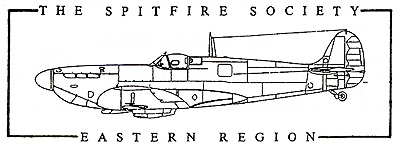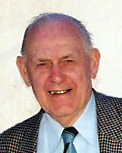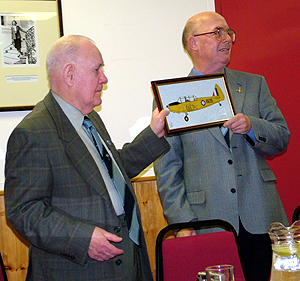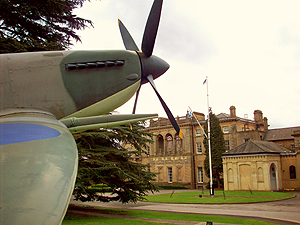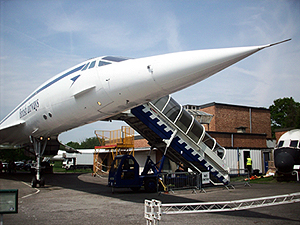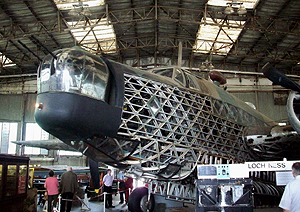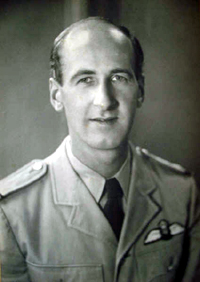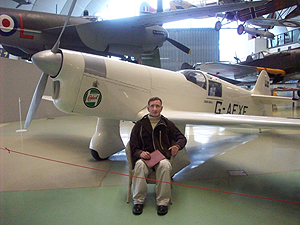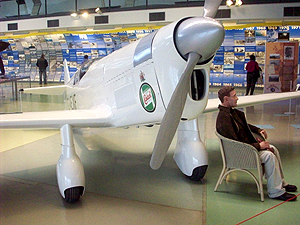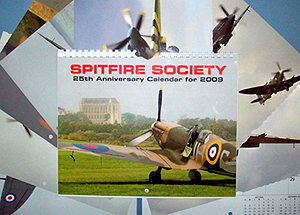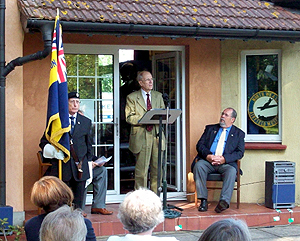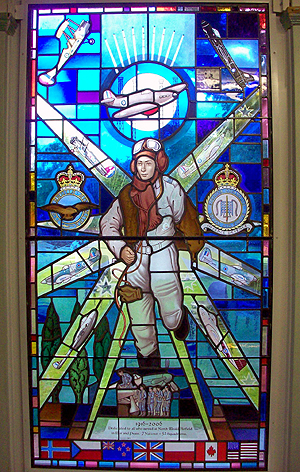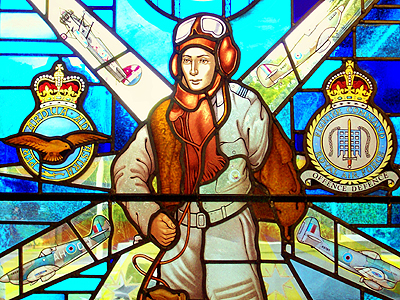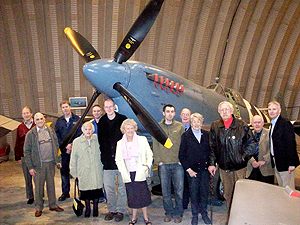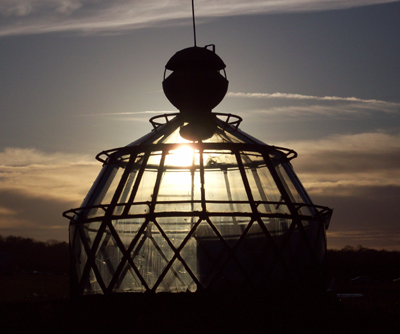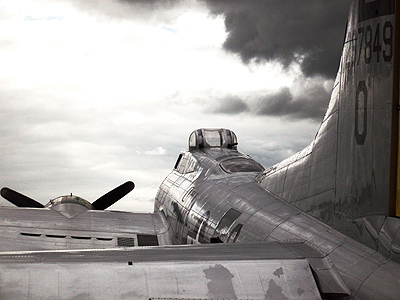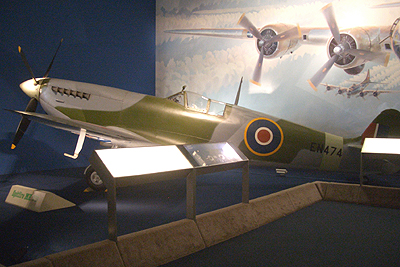 Home Page
Pat Butler
|
INDEX
Clipped Wings and Tail Draggers
The Memoirs of Reg Skolfield - Part 3
----------
It is with deep regret that once again I have
to inform you of the passing of four close friends in our
region. Dot Stillwell and Ken Plumridge in June and Dennis
Nichols and Geoff Lewis in July. The death of Dennis marks the
end of an era that began with the formation of this region and
continued to his final days. I personally feel that I have lost
a true friend, a friend of total integrity.
Our deepest sympathy is extended to Dorothy,
Len and Peggy and to all their families.
On to a brighter note, we are half way
through our air show programme; to date all has gone very well.
We still have two days at Duxford in September and the last show
in October to come.
Once again many thanks to our committee and
to all our helpers, that is what makes it all work.
I wish you all very good health and
prosperity.
With very Kind Regards, David Williams
-----------------------------------
Sadly, we have in recent months lost two of
our key members with the deaths of Dorothy Stillwell and Dennis
Nichols. As the wife of long-time Committee Member Len
Stillwell, Dot’s support over the
years has been invaluable. As for Dennis and the myriad tasks
that he undertook on our behalf it is no exaggeration to say
that without him the Eastern Region would not be where it is
today - in a strong position and looking forward to the future.
Notices on Dennis and Dorothy may be found in this Newsletter.
The following is an extract from a letter
sent to Len Stillwell from Vicky Goodman of the Royal Air Force
Benevolent Fund; “Dear Mr. Stillwell, Thank you very much
for your recent letter enclosing cheques totalling £95.00 from
family and friends in memory of the late Dorothy Stillwell, a
WAAF in Bomber Command, North Yorks., during World War II. On
Behalf of the Chairman and the board of Trustees may I express
our grateful thanks for this kind support for our work, which is
so warmly appreciated.” The letter may be
seen in it’s entirety on our Regional
website. Len has asked me to convey his thanks to all those who
contributed, and to add that a further £70.00 has now been
received. The letter can be found on our
Message Board.
Other members who have now passed away
include former Spitfire Pilots Ken Plumridge and Geoff Lewis who
were both were enthusiastic and active members of our region.
Ken would attend events and air shows when able and would work
hard signing prints and memorabilia to raise funds for our
society. Geoff Lewis was an artist of fine calibre whose
paintings of Spitfires were not only technically accurate,
thanks to his own first hand knowledge, but also very beautiful
and evocative. Over the years he had donated several of these
paintings to the Society to help raise funds. Also recently
deceased are Form 700 contributor Reg Skolfield, and Southern
Region Member Nick Berryman, both members of the Spitfire
Society from its earliest days. Nick,
as you may remember, gave a fascinating interview on the work of
an Air Sea Rescue Spitfire Pilot to the Newsletter a few years
ago; a tireless Society enthusiast, Nick would always give
members a warm welcome at Tangmere Museum where he was a
volunteer.
In other news, Gerard Crutchley has been busy
with the Eastern Region Website (www.spitfiresocietyeastern.org.uk
in case you didn't know by now!) and
has installed a splendid Archives section where visitors may
review some of the best items that have featured on the site and
in the Newsletter, and also a Message Board feature which I
think will prove to be very popular. If you haven’t
visited the site recently do take a look, (I find the Links
Section very useful, in particular the Duxford Update, which
does what it says on the tin and has some splendid photos of
their exhibits, including Jason’s
Airspeed Ambassador) and don’t forget
to tell all your friends about it. As ever, if you have any
comments or feedback, or if there is anything you think could go
on the Notice board, please do contact Gerard (Email and phone
no. on back page of this newsletter). At this point it would
seem opportune to say a special Thank You to Gerard who has been
putting in a great deal of time towards helping get the
Newsletter off the ground following the death of former
Co-Editor Dennis Nichols. It is reasonable to assume that we
will encounter teething problems, but it is with the aim in the
spirit that Dennis always took, of doing the best job that we
possibly can, that Gerard and I are proceeding, so thank you
Gerard. Spitfire Society
Calendars *The
Spitfire Society 25th Anniversary Calendar is now on
sale!Organised by our own Jason Amiss, with stunning photographs
by Garry Lakin it is an absolute must for all members, family,
friends and acquaintances.*
Next, I am very pleased to send special
greetings to Sqn. Ldr. Ian Blair DFM who in July of this year
celebrated his 90th birthday. The occasion was marked
by a wonderful party organised by his family at the ancient and
historic venue of the Officers Mess situated in the Grand House
(former seat of residence of the Duke of Manchester then Lord
Mandeville) at RAF Brampton Park in Cambridgeshire. As well as a
large number of family and friends, the throng of people who
came to wish Ian well included esteemed wartime colleagues from
the Aircrew Association and representatives from various other
oganisations such as the Blenheim Society and the Spitfire
Society. Following a splendid lunch, guests gathered on the lawn
making the most of the weather on that fine sunny day. Suddenly
two Spitfires, a Mk.IX and a Mk.XVI roared low overhead,
wheeling and soaring in the bright blue sky in salute to a great
pilot; what could be more fitting? Congratulations Ian, Many
Happy Returns of the day. Recent Events Eastern
Region 2008 AGM, Old Warden Following
coffee in the Restaurant at Shuttleworth, the day began with the
annual Pat Butler Memorial Awards made in memory of our Region’s
founding father. The proceedings were introduced by our Chairman
David Williams, and the nominees introduced by Steve Williams.
The ceremony was conducted, with his customary style and
graciousness, by former Regional Chairman and 241 Sqn. Spitfire
pilot Dennis Nichols, who sadly has of course since passed away.
As in the past we had two exceptionally gifted awardees, namely
Cadet Flight Sergeant Charlotte Emily Hunt, 2409 Halton Sqn, and
Cadet Flight Sergeant Jonathan Maflin, 444 Shoreditch Sqn. Both
of these remarkable young people already have c.v.’s
as long as one’s proverbial arm,
listing one success after another. We would not want to
embarrass Jonathan and Emily by cataloguing all of their
achievements here, though each Cadet has expressed a wish to
join the Royal Air Force with a view to becoming a pilot and I
am sure that everyone in Eastern Region would like to join me in
wishing them every success with this and all of their future
endeavours. We very much hope that you will continue your
membership of the Spitfire Society in the years ahead and keep
us informed now and again of the progress of your careers.
(Photos can be found in the
Pat Butler
section.)
Following the Pat Butler Awards ceremony an
aircraft-on-glass painting was presented by Steve Williams on
behalf of the Committee and Helpers to David Williams as a token
of appreciation for the relentless hard work that he does as our
Chairman and Treasurer; Thank You David.
The raffle did very well this year, with over
seventy pounds being raised, so well done and thank you to
Audrey Morgan and Audrey Horwood. The prize - a beautiful framed
picture of a Spitfire, of course, - was won by Audrey Morgan who
very kindly offered it to be re-raffled, the eventual winner
being, fittingly, one of our Awardees, Cadet Sergeant Charlotte
Hunt. Well done Charlotte, we hope that it will remind you
always of your association with the Spitfire Society, which we
also hope will be for a long time still to come.
The meeting itself went well enough, the
major queries being the problem of lunchtime Sales Stand
coverage and the question of what direction the Spitfire Society
may take under the new Management team. By way of something a
bit different this year, Gerard Crutchley brought in a laptop
computer so that those members not online could see what our
Regional Website looks like, which was very well received.
Gerard told us that the Website is going well, with a high
number of New Visitors per week. Sadly, despite his commitment
and enthusiasm and with well over a year under his belt now,
Gerard was understandably disappointed that feedback from the
Eastern Region Membership has been noticeably lacking - almost
non-existent in fact. Gerard puts in a lot of time and effort on
our behalf, so come on - lets give him some support and let him
know our thoughts, queries, views, ideas and opinions on our
Website.
Following the meeting we commenced our
behind-the-scenes tour of the Shuttleworth Collection’s
workshop hangers where a number of significant historic aircraft
such as the Blackburn B3, Feisler Storch and Bleriot monoplane
were undergoing maintenance. But it was the Mk.V Spitfire that
everyone wanted to see, and we were not disappointed. The
Aircraft was stripped right down to it’s
main sections, with wings, tail, and engine all removed from the
fuselage which, with paint removed, was a vision of gleaming
bare metal. The components were all in different workshops
through which, in two groups, we were given an extensive and
unhurried tour by the Shuttleworth Staff, who patiently and
thoroughly answered all questions put to them. With so much of
the interior of the aircraft clearly visible this was literally
a chance in a lifetime to study first-hand the workings of this
magnificent aircraft; the last time AR501 had an extensive
overhaul was in the early ‘70’s,
so by that standard it may be thirty or forty years before it
undergoes another one. Thanks to Bob Schofield for organising
the tour, and to the Staff at Old Warden for their kindness and
hospitality.
One major disappointment at this year’s
AGM was that despite an appeal in the March Newsletter for
Regional Members to support the meeting, the attendance this
year was even worse than last year’s
record low, with a total of thirteen people present including
the Committee. Only Mr. and Mrs. Cooper, who support the AGM
every year, represented the non-committee/helpers membership. We
are of course aware that there are many people who for very good
reasons are simply not able to make it to the AGM, but in a
Region of nearly four hundred people there are obviously just as
many who could if they so wished. Following this recent downward
trend it seems likely that unless we receive significant
positive feedback from the Membership, next years AGM will be
held at a much smaller, less costly venue.
The trip in March to RAF Bentley Priory was a
great success, made all the more poignant as with the sale of
the station for redevelopment this may well have been the last
chance to visit this most historic site, at least in its present
form. Bentley Priory was of course the nerve centre of Fighter
Command during the war, and our guide Cindy McCabe gave us a
superb, unhurried tour of the house and grounds which included
Air Marshal Dowding’s beautifully
preserved office. The tour gave a real and tangible insight into
the history of the priory and illuminated less well known
aspects such as the numerous ghosts said to walk the halls and
gardens at night. There was a good attendance of around forty
people on the visit, and we were once again pleased to welcome
guests from Southern Region. Our thanks to RAF Bentley Priory
for their hospitality, to Ian Peak for organising the visit, and
to Cindy for a wonderful tour.
There can be few governments in the world
with as high a level of disrespect and disregard for National
Heritage as that of this country; for who’s
government but ours would let such a significant treasure as
Bentley Priory fall into private ownership to be turned over to
luxury accommodation? The good news is that there is a lobby by
The Bentley Priory Battle of Britain Trust to have part of the
building preserved as an education centre and memorial for the
benefit of future generations. The trust has a superb website,
www.bentleypriory.org which I would strongly
recommend readers to visit.
The get-together at Brooklands in May went
well although numbers were a bit thin on the ground. Regular
supporters of our visits Mr. and Mrs. Camp turned up in force
with their family, and we were also pleased to see our great
friends and Sales Stand helpers Irene and Norman Pascall. The
weather was splendid, the sunshine adding to the nostalgic
atmosphere that Brooklands evokes. For those people who went on
the ‘Concorde Experience’
I’m told this was very interesting
indeed, other people choosing to just wander around the historic
buildings and hangers enjoying the countless wonderful exhibits.
The museum’s Hawker Hurricane
restoration is progressing well, and of course Brooklands is
home to what many people would regard as the jewel in their
crown, Vickers Wellington ‘R for
Robert’, late of Loch Ness. This was a
really grand summer’s day out spent in
the company of good friends. Thanks to Bob for organising it for
us.
P.W. -----------------------------------
Dennis Nichols was born on the 16th
of January 1924. On the 1st of June 2008, following a
short illness he died, and on that day we lost one of our
closest and most well-loved friends.
The Spitfire was always close to Dennis’s
heart having flown the Mk.IX version of this wonderful aeroplane
over Italy with 241 Sqn. during the war. Dennis was also one of
the initial members of the Eastern Region of the Spitfire
Society working in the early days alongside founder Pat Butler.
Dennis performed many roles on our behalf including Treasurer,
Secretary, Newsletter Editor, Sales Stand Helper and of course,
Chairman.
In all of the tasks that he undertook for us
Dennis was always supported and often assisted by his wife, our
dear friend Dorothy Nichols. Much of the work that they did went
unnoticed by the majority of our members, such as assembling all
of the content for the Form 700 newsletter, getting it printed,
and then the long hours spent labeling up and packaging the
hundreds of copies to be posted. But such was Dennis’s nature
that self-promotion of any kind was the furthest ever thing from
his mind. Not only was he concerned with getting the job done,
he also made sure it was completed to as high a standard as
possible, a philosophy which he reflected in all aspects of his
life.
Of course Dennis had many other interests
besides Spitfires; his love of motor cars was widely-known (who
can forget his appearances at Old Warden Members’ Days in the
beautiful vintage Lagonda which he himself had restored?), and
with his passion for computers he was an acknowledged expert in
the field. Slightly less generally known may be that he was a
member of the local Barber Shop Choir in Harlow, or that having
worked for many years around the world in the field of
telecommunications he had adopted a fondness for old and antique
telephones of which he had assembled a large and beautiful
collection.
But above and beyond all else Dennis’s
greatest love and commitment was to his family; his wife
Dorothy, children Helen and Richard, and to all of his
grandchildren, and to them we send our heartfelt sympathy for
their loss.
Dennis was a truly remarkable and wonderful
man. With his intelligence, insight and keen eye for detail, his
dry and dexterous wit was legendary. Generous, warm and kind,
cool and collected in all situations, Dennis was a man of great
strength and integrity and was always, without fail, a true
gentleman. We shall miss him very much.
P.W.
In June of this year we lost one of our
dearest friends with the death of Dorothy Stillwell.
Dot, as we all knew her had been, along with
her husband Len, a supporter of Eastern Region since it’s
earliest days and together were always to be found at Society
functions, meetings, or helping on the Regional Sales Stand at
air shows.
As a WAAF during the war Dot was a camera
technician responsible for installing camera and film on bombers
prior to an operation, then removing the instrument after the
sortie and processing the results. Of course without this vital
work the true accuracy of raids would not be known. One of the
aircraft types that Dot worked on was the Wellington, and it was
with great sadness that she spoke of the heavy losses suffered
and of the young men who went out and never came back. The three
‘Heavies’ were also to benefit from Dot’s attentions, and it was
with some glee that she would recall being taken aloft
unexpectedly on a test-flight on more than one occasion whilst
working on equipment in the nose of the aeroplane (also a
delight for the crew, I’m told!). Of the big three it was the
Halifax, for its ruggedness and reliability, that Dot liked the
most.
After the war Dot continued in the field of
photography as a teacher and also in the specialised field of
airbrush photograph retouching.
In recent years various aspects of Dot’s
health had started to decline and in the face of mounting
difficulties Len never wavered in his single-handed
determination to care for her and that, for the most part,
except when Len himself was taken unwell, Dot did not have to
leave her home which was her great wish.
As a supporter of Eastern Region, Dorothy
Stillwell was highly treasured and a true inspiration to many
younger members such as myself. We have lost a good, kind,
generous and greatly loved friend, and we will remember her
always.
To Len, may I on behalf of the Members,
Helpers, and Committee of Eastern Region offer our condolences
and kindest thoughts.
P.W.
It is with great sadness that I have to
report the death of former 28 Sqn. Pilot Reg Skolfield, who
passed away last year.
Reg had of course contributed extracts from
his memoirs for serialising in the Form 700 - Part Three appears
in this issue. The evocative and atmospheric stories detailing
his adventures around the wartime Mediterranean - both on the
ground and in the air flying Hurricanes and Spitfires - will
have stirred the memories of those who served in that theatre
and the imaginations of those who did not. One can only be
grateful that he was able to put these recollections to paper so
that people such as myself who were born long after the war
finished may have some glimpse into what it was like, at least
for one airman.
One of the founding members of the Spitfire
Society, Reg was an enthusiastic supporter of our region and
would come along to air shows and events whenever possible. A
man of clear insight and very attune to current affairs, Reg and
I would while away many an hour on the ‘phone ‘Putting the World
to Rights.’ I will also remember Reg’s great sense of humour
(which I think is quite evident in his memoirs), his evident
sadness for friends and colleagues who never came home, and of
course his deeply rooted affection for the Spitfire.
P.W.
------------------------------------
In a prestigious ceremony at RAF Hendon
Museum on April the 17th, the replica of the late
Alex Henshaw’s record-setting Percival Mew Gull G-AEXF was
formally handed over. The replica was accepted by the Director
General Dr. Michael Fopp from Alex Henshaw Jr. and builder Tony
Ditheridge of A.J.D. Engineering. The aircraft has been
re-created in tremendous detail.
For a short period the Mew Gull was on the
floor with a mannequin of Alex sitting on a Lloyd Loom chair.
The replica will later be suspended from the ceiling with its
‘pilot’ in the cockpit. It will be in the ‘Milestones of Flight’
gallery.
I felt that it was my special privilege to
receive an invitation to this great event and for that I very
sincerely thank John and Daniel.
David Williams
-------------------------------------
If you are a member of the Spitfire Society
and would like to get extra from your membership, why not get
more involved?
One good way to start is as a volunteer
helper on our Airshow Sales Stand; it’s a great way to meet
like-minded people with an interest in Spitfires (and every
other type of classic aircraft!) including the people who built,
maintained, armed and of course flew these magnificent
aeroplanes. It’s a splendid day out with a great atmosphere, and
you will of course be doing vital work helping to raise the
funds upon which your society depends. It’s also a very good
place to make contacts and in recent years our helpers have
benefited from privileged access to areas not usually available
to the general public and as well as all of that, regular
helpers are granted reduced cost entry to air shows! The work
itself is very straightforward, consisting of either manning the
Sales Stand or selling raffle tickets, and it’s all done in a
friendly, informal way. So if you think it sounds like fun, why
not give it a go - we can always use more help.
Another way to get involved is by
contributing to the Form 700 Newsletter; we are always on the
lookout for new material such as reviews, articles, anecdotes,
in fact anything our readers may be interested in. The ’700 is
of course reproduced in an extended format on our Regional
Website, so your handiwork may be viewed from Tintagel to
Timbuktu! And of course our Webmaster Gerry is always open to
suggestions, feedback, and possible contributions for the site.
Perhaps you would like to get involved with
the actual running of the Region and feel you might like to
become a member of our Committee? If you think you have
something to offer, step forward - we don’t bite!
So there we are, a few ideas and suggestions
- if you’d like more information just get in touch with any
member of the Committee.
You are a member of one of the finest
aviation societies in the world, but remember it doesn’t run
itself, so if you are able to, why not:
Get Involved Today?
-------------------------------------------
Ken Bradley If you have not read Part I, you can find
it here:
Having successfully completed E.F.T.S., we
were sorry to leave it behind us, and the many delights of the
city of Johannesburg, but we wished to find where the next stage
of our training would take place, namely, S.F.T.S. This, in my
case turned out to be No 27 Air School, Bloemfontein, in the
Orange Free State, where we quickly settled in to new quarters
to the sounds of the aircraft we were to fly, the Pratt &
Whitney radial engined Harvard - a sound all of its' own - soon
to become very familiar and reassuring, once airborne.
Introductions swiftly took place, firstly to
the lovely aircraft, then, more importantly, to our instructors
for the course. I was assigned to 'A' Flight Group and F/O
Cotterell, to whom I owe a great deal throughout for his flying
instruction.
Following initial tests and approximately six
hours dual, I was allowed to fly an hour solo, to include a few
take-off and landings, with the instructor nearby keeping a
close watch each time. It was incredible; the difference in
power and handling to the Tiger Moth, but it was absolutely
fine. The aircraft has no vices at all and the visibility from
the front seat, just great.
(October 1944) For the next four months,
including intensive course work, we were airborne for 2-3 hours
each flying day. This consisted of general flying, aerobatics,
formation, cross-country, night flying air to air, air to ground
and instrument flying - a very full programme indeed. This was
all made possible because of the ideal weather conditions in
South Africa. With final test looming towards the end of
January, my training, along with other trainee pilots, proved
successful.
The great day arrived mid-February - Wings
Parade - a couple of weeks prior to my 21st birthday. What a
present, awarded the R.A.F. Flying Badge and no-one in the
family to share the excitement with!! We did, however, have a
great party in the mess following the presentations.
Following on from the success of the course
(and the party), a few of us had some leave and went to Cape
Town. On our return, we heard that someone had dropped out from
a posting to the Middle East for further training at O.T.U. At
the time, they were waiting in Durban and I was selected to join
them so travelled by train from Bloemfontein (not a lot of
scenery by the way!). Once there, we changed into civilian
attire (for some reason or other) and we boarded a B.O.A.C.
Short Sunderland flying boat for the journey up through the Horn
of Africa and the Nile Delta, taking a couple of days at
leisure, landing at Suez, and finally on to No 73 O.T.U. Fayid,
near the canal. Little did I realize that only 9 months or so
earlier, I was on the ship going the other way to Durban!
The next day, following the initial welcome and pep talk, we
were taken to the dispersal point, and the aircraft we were to
fly for the next part of our training. For me, this was the most
exciting part. ...... to be continued ------------------------------------- Clipped Wings and Tail Draggers Many wartime British Fighter Pilots went across the Atlantic to do their Initial Training, and the aircraft favoured by our American cousins for this purpose was the Boeing Stearman; a fine, sturdy biplane - a good number of which may still be seen flying today. Former Regional Committee Member and current Stearman Association Member, Ron Gould trained on the Stearman and sent us the following item; unfortunately the photographs were too faded to reproduce, but I’m sure you will still find it very interesting. ‘During Primary Training at Darr Airfield, GA, USA, rumour had it that an earlier cadet had ridden the tail of a Stearman. His instructor not having a good time after a heavy night out, demonstrated his wrath at his pupil’s efforts by slamming the stick forward, and out popped the cadet. This was never confirmed, so the rumour appeared to die. That is until 1998, 56 years later. Out of the blue, a Canadian, having learned of our Assn. sent a newspaper cutting dated Feb. 8, 1942 from the New York Sunday News; he thought that we would be interested to see the photographs and captions. Proof that Derek Sharp not only rode the tail of a Stearman at Tuskaloosa but later that week, climbing from the cockpit after landing his ship, another, also landing, sheered off his upper starboard wing. I have since heard that Derek was killed on Lancs, but cannot confirm. R.G.’ New York Sunday News, Feb. 8, 1942; ‘Close Shave Again.’ ‘Lucky. Twice in a week RAF Cadet Derek M. Sharp of Yorkshire, England, in training at Tuscaloosa, Ala., missed death by a whisker. This his latest exploit; he was climbing from the cockpit of his plane when another ship, coming in for landing, sheered off a wing. Sharp, unhurt, grins as he inspects the damage. Luck then, too. Cadet Sharp, the flying Yorkshireman, shows how he rode the tail of a plane to a safe landing. He was thrown from his seat during a training flight but managed to straddle the fuselage and get a kind of grip on things until the instructor landed the ship safely.’ Steve Williams adds: '... sadly, I can confirm that Derek Sharp's luck finally ran out on the 26th June 1943. He was the pilot of Lancaster R5740 which was 'lost without trace' on a mission to Gelsenkirchen. Derek and his crew are all commemorated on the Runnymede Memorial.'
------------------------------------------- Now Available! The superb calendar for 2009 is now obtainable, featuring sumptuous glossy pictures on every page of everyone’s favourite aeroplane by renowned photographer Garry Lakin.
The calendar has lots of space for daily appointments, with all twelve months of next year included and even Bank Holidays thrown in for free! Measuring nearly 10” by 15” (open), this item would really look great on any wall, so why not be the envy of all your friends and be the first in your street to own one? (In fact if you really like your friends, why not buy them all one, or at least put a few by for Christmas presents?) The price is an incredibly miserly £5.00, plus a pound for p&p, and as you know, it all goes to a very worthwhile cause. Please see the Merchandise section to purchase, or avoid p&p by buying from the Sales Stand.
------------------------------------- Part III If you have not read Part I & II, you can find them here: We were posted to 28 Squadron, on Tactical Reconnaissance in support of the Fourteenth Army, flying Hurricanes armed with four 20 millimeter cannon, and two cameras, one oblique, one vertical. The Hurricanes had been sent from the Middle East and were well-used. However, with excellent servicing they were quite acceptable, though slow. We personally were very fortunate, since the Japanese had been pushed back from their thrust to Imphal, when they had hoped to conquer India itself. So in the main we swept down to Rangoon step by step during the following six months. We were flown out to Imphal, then Tamu, then Kalaymyo by the ubiquitous DC3, the Dakota so named by affectionate crews. It had been a pre-war American airliner, and the devotion inspired by this remarkable aircraft by those fortunate enough to be involved with her (I say her because it must have been a 'she') was extraordinary. It was at Kalaymyo that we began our flying. The Squadron was commanded by Squadron Leader Henry Larsen, with two Flights, ours being B, with Flight Lieutenant Ken MacVicar in charge. Here the Hurricane was equipped with two long range fuel tanks, giving a flight time of about three hours. Our instructions were to fly tree-top height or below. The problem with that is you could not spot very much at this level, and if you flew higher it was ten to one you would be shot at. Indeed on one of my first trips over Maymyo, a favourite hill-station for British diplomats before the War, I had a couple of bullets in the petrol tank on the port side. The damage was quickly sealed over by the material used, but I caught an alarming whiff of petrol. One of the first trips I had was with a senior experienced Canadian. He attacked a train, and I followed suit, all guns blazing. He told me afterwards that I had not allowed for the pull-out after the dive, and nearly hit the train with my tail. The idea was to have two planes go in partnership, one to spy out the land, the other to give support. I used to watch him circling about at some fifty feet, because he was so thorough and a most excellent pilot. One day he did not return. The next trip was with our Commander Henry Larsen, he taking photographs near Mandalay at 5000 ft, and I circling above. On that occasion we had flak, but not very accurate, and we got away with it. Henry Larsen later went to Headquarters as Wing Commander, and we missed him greatly, After the War he was testing the Flying Bedstead, and was killed when it crashed from about forty feet. They were developing the Harrier. Our next chief was Squadron Leader Pannell. He only had a few trips before his plane was brought down. In the last to be seen of him he was clambering out of his plane and running into the bush. At our camp we were housed in tents, one of which I shared with Bob Sheppard, still the immaculate Englishman smoking his pipe. He was probably one of the most efficient people on the Squadron. The next tent down a small incline was inhabited by Dave Williamson and Gavin Douglas. Duggie I had met while at the Heliopolis Hotel in Cairo. He was a Britisher serving with the Indian Army, and seconded to the RAF. He had a family in Bangalore. The latrine in the jungle filled me with horror, for it was one big hole surmounted by two boxes side by side. And the mess down below was swarming with flies. I could not face this ordeal and started to take a spade with me into the Jungle, a much more efficient operation I believed. Duggie reported me to the Medical Officer, who ought to have known better about hygiene. The only thing to do was to use this abominable place after dark, which I did most of the time thereafter. It was easy to forget to switch over to main tanks once the long-range tanks were exhausted. During a forced landing one fellow hit his head on the gun sight, placed so prominently in front of the pilot, and had to be sent to hospital, never to return to duty. Then MacVicar and another Canadian, Johnnie Johnson, were brought down and had to walk back through the jungle, one taking eighteen days, the other twenty-two days to get back to base. Talk about the jungle school in far-off Mahabaleshwar. They both existed on something like a couple of Horlicks tablets a day. I saw Johnnie when he returned and he was as thin as a rake. He was dispatched to Aircrew House in Calcutta to recover, and in a month had put all his weight back on, and more besides. How they ever made it is something to wonder about, and says much for their courage, fortitude and tenacity. After the war, Ken MacVicar became a minister in the Presbyterian Church in Scotland. Low flying suited me best. I had not liked it at all when, during a high-altitude test on oxygen at Dothan, 1 found myself at 20,000 ft all alone in this thin aluminium shell, looking down at the ground ever so far away. And in the Decompression Chamber in Poona, I was not comfortable at 27,000 ft. The old Hurricane was marvellous, and I felt very confident in it. With our armament we could set a whole village on fire if we wanted, but we didn't want. Once climbing up a hill side the temperature went up to 120 degrees, while the airspeed was merely 110 mph. But still the old bird got to the top. Once we attacked a Jap gun post, and it was the oddest thing to see men draped over their guns, while in the river a few hundred yards away our soldiers bathed, their bodies so white, as though it was another world they were in. I had tipped my propeller and bent the blade on a tree once, but on one occasion I had been flying along a road when I looked ahead and saw a giant tree right in front of me, I frantically jerked the stick into my left side and shot through the tree at an angle. When I looked at the wing the lights were smashed and wires were hanging out. I went up to a 1000 ft and tested for stalling. The old Hurricane was just the same, but I flew back to base as fast as I could. When safely landed the Engineering Officer came to take a look. ‘Good Lord’ he said, ‘you were lucky. The oil cooler has been swiped off, and you've only about a pint of oil left’. I had been inside Japanese lines by about a hundred miles. .... to be continued --------------------------------------
On the 14th of September 2008 a new stained glass window commemorating the 90th Anniversary of North Weald Airfield was unveiled by Lord Tebbit at Ad Astra House, the North Weald Airfield Museum. Dedicated to all those who served at North Weald during it’s years as an RAF station, the window depicts an airman rushing to ‘Scramble’ and a selection of aircraft which flew from the airfield including the Hunter, Meteor, Vampire, Typhoon, Hurricane and of course Spitfire.
Eastern Region visit to Peter Teichman's Hangar 11 at North Weald:
A lovely photo by Peter Wesson of the old beacon at Hatfield Airfield:
And this one by Cliff Wesson - the B17 at Duxford:
A photo sent in by Simon Foster of the MKVII at the Smithsonian National Air and Space Museum:
We appreciate the photos you send us and endeavour to reproduce as many as possible - so please keep them coming. And finally our air show raffle prize winners - congratulations to all.
And thank you to our young volunteers for picking the winning numbers - featured here are Alfie and James:
--------------------------------------- Form 700
is produced by Peter Wesson and Gerard Crutchley. The previous issue of
Form 700 (#52 Spring 2008) can be found here: |
||

